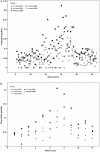Use of population health data to refine diagnostic decision-making for pertussis
- PMID: 20064807
- PMCID: PMC2995623
- DOI: 10.1197/jamia.M3061
Use of population health data to refine diagnostic decision-making for pertussis
Abstract
Objective: To improve identification of pertussis cases by developing a decision model that incorporates recent, local, population-level disease incidence.
Design: Retrospective cohort analysis of 443 infants tested for pertussis (2003-7).
Measurements: Three models (based on clinical data only, local disease incidence only, and a combination of clinical data and local disease incidence) to predict pertussis positivity were created with demographic, historical, physical exam, and state-wide pertussis data. Models were compared using sensitivity, specificity, area under the receiver-operating characteristics (ROC) curve (AUC), and related metrics.
Results: The model using only clinical data included cyanosis, cough for 1 week, and absence of fever, and was 89% sensitive (95% CI 79 to 99), 27% specific (95% CI 22 to 32) with an area under the ROC curve of 0.80. The model using only local incidence data performed best when the proportion positive of pertussis cultures in the region exceeded 10% in the 8-14 days prior to the infant's associated visit, achieving 13% sensitivity, 53% specificity, and AUC 0.65. The combined model, built with patient-derived variables and local incidence data, included cyanosis, cough for 1 week, and the variable indicating that the proportion positive of pertussis cultures in the region exceeded 10% 8-14 days prior to the infant's associated visit. This model was 100% sensitive (p<0.04, 95% CI 92 to 100), 38% specific (p<0.001, 95% CI 33 to 43), with AUC 0.82.
Conclusions: Incorporating recent, local population-level disease incidence improved the ability of a decision model to correctly identify infants with pertussis. Our findings support fostering bidirectional exchange between public health and clinical practice, and validate a method for integrating large-scale public health datasets with rich clinical data to improve decision-making and public health.
Conflict of interest statement
Figures

Similar articles
-
Predicting pertussis in infants.Pediatr Emerg Care. 2008 Jan;24(1):16-20. doi: 10.1097/pec.0b013e31815f39b6. Pediatr Emerg Care. 2008. PMID: 18165797
-
Incidence of Severe and Nonsevere Pertussis Among HIV-Exposed and -Unexposed Zambian Infants Through 14 Weeks of Age: Results From the Southern Africa Mother Infant Pertussis Study (SAMIPS), a Longitudinal Birth Cohort Study.Clin Infect Dis. 2016 Dec 1;63(suppl 4):S154-S164. doi: 10.1093/cid/ciw526. Clin Infect Dis. 2016. PMID: 27838668 Free PMC article.
-
Machine learning-based risk prediction model for pertussis in children: a multicenter retrospective study.BMC Infect Dis. 2025 Mar 27;25(1):428. doi: 10.1186/s12879-025-10797-7. BMC Infect Dis. 2025. PMID: 40148755 Free PMC article.
-
Clinically Diagnosing Pertussis-associated Cough in Adults and Children: CHEST Guideline and Expert Panel Report.Chest. 2019 Jan;155(1):147-154. doi: 10.1016/j.chest.2018.09.027. Epub 2018 Oct 12. Chest. 2019. PMID: 30321509 Free PMC article. Review.
-
Public health perspectives on the rising incidence of pertussis.Public Health Nurs. 2007 Sep-Oct;24(5):421-8. doi: 10.1111/j.1525-1446.2007.00652.x. Public Health Nurs. 2007. PMID: 17714226 Review.
Cited by
-
Improved diagnostic accuracy of group A streptococcal pharyngitis with use of real-time biosurveillance.Ann Intern Med. 2011 Sep 20;155(6):345-52. doi: 10.7326/0003-4819-155-6-201109200-00002. Ann Intern Med. 2011. PMID: 21930851 Free PMC article.
-
Desiderata for computable representations of electronic health records-driven phenotype algorithms.J Am Med Inform Assoc. 2015 Nov;22(6):1220-30. doi: 10.1093/jamia/ocv112. Epub 2015 Sep 5. J Am Med Inform Assoc. 2015. PMID: 26342218 Free PMC article.
-
Clinical research informatics: a conceptual perspective.J Am Med Inform Assoc. 2012 Jun;19(e1):e36-42. doi: 10.1136/amiajnl-2012-000968. Epub 2012 Apr 20. J Am Med Inform Assoc. 2012. PMID: 22523344 Free PMC article.
-
Combining Nonclinical Determinants of Health and Clinical Data for Research and Evaluation: Rapid Review.JMIR Public Health Surveill. 2019 Oct 7;5(4):e12846. doi: 10.2196/12846. JMIR Public Health Surveill. 2019. PMID: 31593550 Free PMC article. Review.
-
Integrating spatial epidemiology into a decision model for evaluation of facial palsy in children.Arch Pediatr Adolesc Med. 2011 Jan;165(1):61-7. doi: 10.1001/archpediatrics.2010.250. Arch Pediatr Adolesc Med. 2011. PMID: 21199982 Free PMC article.
References
-
- Cherry JD. Pertussis in adults. Ann Intern Med 1998;128:64–6 - PubMed
-
- Lee GM, Lett S, Schauer S, et al. Societal costs and morbidity of pertussis in adolescents and adults. Clin Infect Dis 2004;39:1572–80 - PubMed
-
- Sotir MJ, Cappozzo DL, Warshauer DM, et al. A countywide outbreak of pertussis: initial transmission in a high school weight room with subsequent substantial impact on adolescents and adults. Arch Pediatr Adolesc Med 2008;162:79–85 - PubMed
-
- Murphy TV, Slade BA, Broder KR, et al. Prevention of pertussis, tetanus, and diphtheria among pregnant and postpartum women and their infants: recommendations of the Advisory Committee on Immunization Practices (ACIP). MMWR Morb Mortal Wkly Rep 2008;57:1–47 - PubMed
-
- Davis JP. Clinical and economic effects of pertussis outbreaks. Pediatr Infect Dis J 2005;24(6 Suppl):S109–16 - PubMed
Publication types
MeSH terms
Grants and funding
LinkOut - more resources
Full Text Sources
Medical

